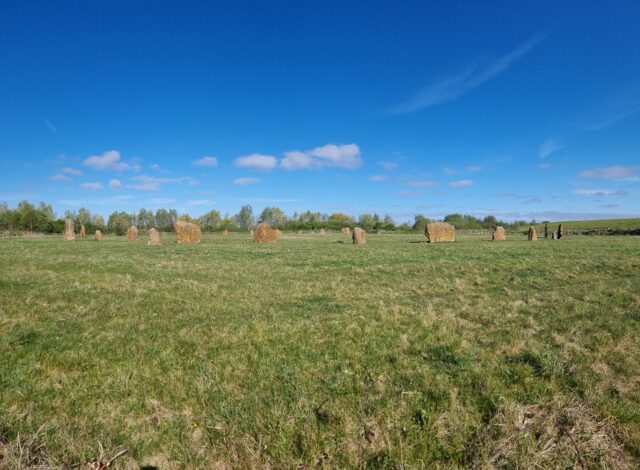Tintern Abbey’s looking especially beautiful in the fresh snow, this morning.
Tag: history
Best Viewed at: Your Resolution!
Way back in the day, websites sometimes had banners or buttons (often 88×31 pixels, for complicated historical reasons) to indicate what screen resolution would be the optimal way to view the site. Just occasionally, you still see these today.
![]()
![]()
![]()
![]()
Folks who were ahead of the curve on what we’d now call “responsive design” would sometimes proudly show off that you could use any resolution, in the same way as they’d proudly state that you could use any browser1!
![]()
![]()
![]()
![]()
I saw a “best viewed at any size” 88×31 button recently, and it got me thinking: could we have a dynamic button that always shows the user’s current resolution as the “best” resolution. So it’s like a “best viewed at any size” button… except even more because it says “whatever resolution you’re at… that’s perfect; nice one!”
Turns out, yes2:
![]()
Anyway, I’ve made a website: best-resolution.danq.dev. If you want a “Looks best at [whatever my visitor’s screen resolution is]” button, you can get one there.
It’s a good job I’ve already done so many stupid things on the Web, or this would make me look silly.
Footnotes
1 I was usually in the camp that felt that you ought to be able to access my site with any browser, at any resolution and colour depth, and get an acceptable and satisfactory experience. I guess I still am.
2 If you’re reading this via RSS or have JavaScript disabled then you’ll probably see an “any size” button, but if you view it on the original page with JavaScript enabled then you should see your current browser inner width and height shown on the button.
Just a Little More Context Bro, I Promise, and It’ll Fix Everything
This is a repost promoting content originally published elsewhere. See more things Dan's reposted.
…
Solving problems with LLMs is like solving front-end problems with NPM: the “solution” comes through installing more and more things — adding more and more context, i.e. more and more packages.
- LLM: Problem? Add more context.
- NPM: Problem? There’s a package for that.
…
As I’m typing this, I’m thinking of that image of the evolution of the Raptor engine, where it evolved in simplicity:
This stands in contrast to my working with LLMs, which often wants more and more context from me to get to a generative solution:
…
Jim Nielsen speaks to my experience, here. Because a programming LLM is simply taking inputs (all of your code, plus your prompt), transforming it through statistical analysis, and then producing an output (replacement code), it struggles with refactoring for simplicity unless very-carefully controlled. “Vibe coding” is very much an exercise in adding hacks upon hacks… like the increasingly-ludicrous epicycles introduced by proponents of geocentrism in its final centuries before the heliocentric model became fully accepted.

I don’t think that AIs are useless as a coding tool, and I’ve successfully used them to good effect on several occasions. I’ve even tried “vibe coding”, about which I fully agree with ‘s observation that “vibe code is legacy code”. Being able to knock out something temporary, throwaway, experimental, or for personal use only… while I work on something else… is pretty liberating.
For example: I couldn’t remember my Google Sheets API and didn’t want to re-learn it from the sprawling documentation site, but wanted a quick personal tool to manipulate such a sheet from a remote system. I was able to have an AI knock up what I needed while I cooked dinner for the kids, paying only enough attention to check-in on its work. Is it accessible? Is it secure? Is it performant? Is it maintainable? I can’t answer any of those questions, and so as a professional software engineer I have to reasonably assume the answer to all of them is “no”. But its only user is me, it does what I needed it to do, and I didn’t have to shift my focus from supervising children and a pan in order to throw it together!
Anyway: Jim hits the nail on the head here, as he so often does.
Riding With Strangers: California Hitchhikers in the 1970s
This is a repost promoting content originally published elsewhere. See more things Dan's reposted.
…
“For years, starting in the late ‘70s, I was taking pictures of hitchhikers. A hitchhiker is someone you may know for an hour, or a day, or, every so often, a little longer, yet, when you leave them, they’re gone. If I took a picture, I reasoned, I’d have a memory. I kept a small portfolio of photos in the car to help explain why I wanted to take their picture. This helped a lot. It also led me to look for hitchhikers, so that I could get more pictures.
“I almost always had a camera… I finally settled on the Olympus XA – a wonderful little pocket camera. (I’ve taken a picture of the moon rising with this camera.) One time I asked a chap if I could take a photo, and he said, “You took my picture a few years ago.” I showed him the album and he picked himself out. “That’s me,” he said, pointing…”
…
Not that hitch-hiking is remotely as much a thing today as it was 50 years ago, but even if it were then it wouldn’t be so revolutionary to, say, take a photo of everybody you give a ride to. We’re all carrying cameras all the time, and the price of taking a snap is basically nothing.
But for Doug Biggert, who died in 2023, began doing this with an analogue camera as he drove around California from 1973 onwards? That’s quite something. Little wonder he had to explain his project to his passengers (helped, later on, by carrying a copy of the photo album he’d collected so-far that he could show them).
A really interesting gallery with a similarly-compelling story. Also: man – look at the wear-and-tear on his VW Bug!
Part of the Internet, or connecting to the Internet?
Some time in the last 25 years, ISPs stopped saying they made you “part of” the Internet, just that they’d help you “connect to” the Internet.
Most people don’t need a static IP, sure. But when ISPs stopped offering FTP and WWW hosting as a standard feature (shit though it often was), they became part of the tragic process by which the Internet became centralised, and commoditised, and corporate, and just generally watered-down.
The amount of effort to “put something online” didn’t increase by a lot, but it increased by enough that millions probably missed-out on the opportunity to create their first homepage.
Note #26938
The Local Historian
Back in 2021, as part of a course I was doing at work, I made a video talking about The Devil’s Quoits, a henge and stone circle near where I live.

Two years later, our eldest was at school and her class was studying the stone age. Each of three groups were tasked with researching a particular neolithic monument, and our eldest was surprised when she heard my voice coming from a laptop elsewhere in the class. One of her classmates had, in their research into the Quoits, come across my video.
And so when their teacher arranged for a school trip to the Devil’s Quoits, she asked if I could go along as a “local expert”. And so I did.

And so this year, when another class – this time featuring our youngest – went on a similar school trip, the school asked me to go along again.
I’d tweaked my intro a bit – to pivot from talking about the archaeology to talking about the human stories in the history of the place – and it went down well: the children raised excellent observations and intelligent questions1, and clearly took a lot away from their visit. As a bonus, our visit falling shortly after the summer solstice meant that local neopagans had left a variety of curious offerings – mostly pebbles painted with runes – that the kids enjoyed finding (though of course I asked them to put each back where they were found afterwards).
But the most heartwarming moment came when I later received an amazing handmade card, to which several members of the class had contributed:

I don’t know if I’ll be free to help out again in another two years, if they do it again2: perhaps I should record a longer video, with a classroom focus, that shares everything I know about The Devil’s Quoits.
But I’ll certainly keep a fond memory of this (and the previous) time I got to go on such a fun school trip, and to be an (alleged) expert about a place whose history I find so interesting!
Footnotes
1 Not every question the children asked was the smartest, but every one was gold. One asked “is it possible aliens did it?” Another asked, “how old are you?”, which I can only assume was an effort to check if I remembered when this 5,000-year-old hengiform monument was being constructed…
2 By lucky coincidence, this year’s trip fell during a period that I was between jobs, and so I was very available, but that might not be the case in future!
Historical Tech Tree
This is a repost promoting content originally published elsewhere. See more things Dan's reposted.
This wonderful project, released six weeks ago, attempts the impossible challenge of building a Civilization-style tech tree but chronicling the development and interplay of all of the actual technological innovations humanity has ever made. Even in its inevitably-incomplete state, it’s inspiring and informative. Or, as Open Culture put it:
Our civilization has made its way from stone tools to robotaxis, mRNA vaccines, and LLM chatbots; we’d all be better able to inhabit it with even a slightly clearer idea of how it did so.
Note #26759
What If the EU Never Existed?
This is a repost promoting content originally published elsewhere. See more things Dan's reposted.
This video, which I saw on Nebula but which is also available on YouTube, explores a hypothetical alternate history in which the Schuman Plan/European Coal & Steel Community never happened, and the knock-on effects lead to no EU, a more fragmented Europe, and an ultimately more-fractured and more-complicated Europe of the late 20th/early 21st century.
Obviously it’s highly-speculative and you could easily come up with your own alternative alternative history! But the Twilight Struggle player in me as well as the alternate history lover (and, of course, European Union fan) especially loves the way this story is told.
It’s worth remembering that for the last half-millenium or more, the default state of Europe has been to be fighting one another: if not outright war then at least agressive economic and political rivals. Post-WWII gave Europe perhaps its longest ever period of relative peace, and that’s great enough that all of the other benefits of a harmonised and cooperative union are just icing on the cake.
EU Made Simple is a fantastic channel in general, and I’d recommend you give it a look. It ties news and history in with its creators outlook, but it’s always clear which bits are opinion and it’s delightfully bitesized. For Europeans-in-exile in this post-Brexit age, it’s hopeful and happy, and I like it.
Happy Europe Day, one and all.
Easter Sunday Stone Circle
Why is there a “small house” in IBM’s Code page 437?
This is a repost promoting content originally published elsewhere. See more things Dan's reposted.
There’s a small house ( ⌂ ) in the middle of IBM’s infamous character set Code Page 437. “Small house”—that’s the official IBM name given to the glyph at code position 0x7F, where a control character for “Delete” (DEL) should logically exist. It’s cute, but a little strange. I wonder, how did it get there? Why did IBM represent DEL as a house, of all things?
…
It probably ought to be no surprise that I, somebody who’s written about the beauty and elegance of the ASCII table, would love this deep dive into the
specifics of the unusual graphical representation of the DEL character in IBM Code Page 437.
It’s highly accessible, so even if you’ve only got a passing interest in, I don’t know, text encoding or typography or the history of computing, it’s a great read.
Dan Q 88×31
Reading more rolled papyri
In kind-of local news, I see that the folks at Diamond Light Source (which I got to visit last year) have been helping the Bodleian (who I used to work for) to X-ray one of their Herculaneum scrolls (which I’ve written about before). That’s really cool.
Yr Wyddfa’s First Email
On Wednesday, Vodafone announced that they’d made the first ever satellite video call from a stock mobile phone in an area with no terrestrial signal. They used a mountain in Wales for their experiment.
It reminded me of an experiment of my own, way back in around 1999, which I probably should have made a bigger deal of. I believe that I was the first person to ever send an email from the top of Yr Wyddfa/Snowdon.
Nowadays, that’s an easy thing to do. You pull your phone out and send it. But back then, I needed to use a Psion 5mx palmtop, communicating over an infared link using a custom driver (if you ever wondered why I know my AT-commands by heart… well, this isn’t exactly why, but it’s a better story than the truth) to a Nokia 7110 (fortunately it was cloudy enough to not interfere with the 9,600 baud IrDA connection while I positioned the devices atop the trig point), which engaged a GSM 2G connection, over which I was able to send an email to myself, cc:’d to a few friends.
It’s not an exciting story. It’s not even much of a claim to fame. But there you have it: I was (probably) the first person to send an email from the summit of Yr Wyddfa. (If you beat me to it, let me know!)










